Study on the Response Mechanism of Climate and Land Use Change to Evapotranspiration in Aksu River Basin
Abstract
:1. Introduction
2. Materials and Methods
2.1. Study Area
2.2. Data
2.2.1. MOD16 Evapotranspiration Data
2.2.2. Meteorological Data
2.2.3. Land Use Data
2.3. Methods
2.3.1. Analysis of the Trend and Mann–Kendal Test
2.3.2. Simple Correlation Analysis
2.3.3. Partial Correlation Analysis
2.3.4. Complex Correlation Analysis
2.3.5. Guidelines for Driving Zoning
3. Results
3.1. Characteristics of Spatial and Temporal Changes in Evapotranspiration
3.1.1. Analysis of Temporal Changes in Evapotranspiration
3.1.2. Analysis of Spatial Variation in Evapotranspiration
3.2. Impact of Climate Change on Spatial and Temporal Changes in Evapotranspiration
3.2.1. Analysis of the Correlation between Evapotranspiration and Climatic Factors
3.2.2. Bicorrelation and Complex Correlation Analysis between Evapotranspiration and Climatic Factors
3.2.3. Analysis of the Drivers of Evapotranspiration and Climatic Factors
3.3. Impacts of Land Use Change on Spatial and Temporal Changes in Evapotranspiration
3.3.1. Characteristics of Spatiotemporal Changes in Evapotranspiration for Different Types of Land Use
3.3.2. Zoning of the Drivers of Evapotranspiration in the Context of Land Use and Climate Change
4. Discussion
5. Conclusions
Author Contributions
Funding
Institutional Review Board Statement
Informed Consent Statement
Data Availability Statement
Conflicts of Interest
References
- Ding, L.; Yu, Y.; Zhang, S. Trend Projections of Potential Evapotranspiration in Yangtze River Delta and the Uncertainty. Atmosphere 2024, 15, 357. [Google Scholar] [CrossRef]
- Fisher, J.B.; Meiton, F.; Middleton, E.; Hain, C.; Anderson, M.; Allen, R.; McCabe, M.F.; Hook, S.; Baldocchi, D.; Wood, E.F.; et al. The future of evapotranspiration: Global requirements for ecosystem functioning, carbon and climate feedbacks, agricultural management, and water resources. Water Resour. Res. 2017, 53, 2618–2626. [Google Scholar] [CrossRef]
- Li, X.; Zou, L.; Xia, J.; Dou, M.; Li, H.; Song, Z. Untangling the effects of climate change and land use/cover change on spatiotemporal variation of evapotranspiration over China. J. Hydrol. 2022, 612, 128189. [Google Scholar] [CrossRef]
- Jasechko, S.; Sharp, Z.D.; Gibson, J.J.; Birks, S.J.; Yi, Y.; Fawcett, P.J. Terrestrial water fluxes dominated by transpiration. Nature 2013, 496, 347–350. [Google Scholar] [CrossRef]
- Prvlie, R.; Piticar, A.; Roca, B.; Sfîcă, L.; Bandoc, G.; Tiscovschi, A.; Patriche, C. Spatio-temporal changes of the climatic water balance in Romania as a response to precipitation and reference evapotranspiration trends during 1961–2013. Catena 2019, 172, 295–312. [Google Scholar] [CrossRef]
- Dey, P.; Mishra, A. Separating the impacts of climate change and human activities on streamflow: A review of methodologies and critical assumptions. J. Hydrol. 2017, 548, 278–290. [Google Scholar] [CrossRef]
- Wang, Q.; Cheng, L.; Zhang, L.; Liu, P.; Qin, S.; Liu, L.; Jing, Z. Quantifying the impacts of land-cover changes on global evapotranspiration based on the continuous remote sensing observations during 1982–2016. J. Hydrol. 2021, 598, 126231. [Google Scholar] [CrossRef]
- Li, X.; Pang, Z.; Xue, F.; Ding, J.; Wang, J.; Xu, T.; Xu, Z.; Ma, Y.; Zhang, Y.; Shi, J. Analysis of Spatial and Temporal Variations in Evapotranspiration and Its Driving Factors Based on Multi-Source Remote Sensing Data: A Case Study of the Heihe River Basin. Remote Sens. 2024, 16, 2696. [Google Scholar] [CrossRef]
- Dunne, K.A.; Millly, P.C.D. Potential evapotranspiration and continental drying. Nat. Clim. Chang. 2016, 6, 946–949. [Google Scholar] [CrossRef]
- Zhang, S.; Zhang, P.; Zhang, R.; Liu, T. Estimation of growing season evapotranspiration and its variation in a typical area of Horqin Sandy Land. Adv. Water Sci. 2018, 29, 768–778. (In Chinese) [Google Scholar] [CrossRef]
- Huang, K.; Lu, Y.; Wei, Z.; Chen, H.; Zhang, B.; Ma, W. Effects of Land Use and Climate Change on Spatiotemporal Changes of Evapotranspiration in Haihe River Basin. J. Geo-Inf. Sci. 2019, 21, 1888–1902. (In Chinese) [Google Scholar]
- Zhang, Z.; Li, R.; Wang, X.; Wang, Y.; Jia, B. Spatio-temporal variation of evapotranspiration in Hetao lrrigated Area and its driving force analysis. Ecol. Sci. 2023, 42, 9–17. (In Chinese) [Google Scholar]
- Mu, Q.; Heinsch, F.A.; Zhao, M.; Running, S.W. Development of a global evapotranspiration algorithm based on MODIS and global meteorology data. Remote Sens. Environ. 2007, 111, 519–536. [Google Scholar] [CrossRef]
- Yang, J.; Zhou, X.; Cheng, D.; Zhang, J.; Niu, Q. Spatiotemporal Change Characteristics of MOD16 Evapotranspiration in Different Geomorphic Types of Guizhou Province. Res. Soil Water Conserv. 2019, 26, 216–222. (In Chinese) [Google Scholar]
- Zhang, K.; Zhu, G.; Ma, J.; Ma, J.; Yang, Y.; Shang, S.; Gu, C. Parameter analysis and estimates for the modis evapotranspiration algorithm and multiscale verification. Water Resour. Res. 2019, 55, 2211–2231. [Google Scholar] [CrossRef]
- Dzikiti, S.; Jovanovic, N.Z.; Bugan, R.D.; Ramoelo, A.; Majozi, N.P.; Nickless, A.; Cho, M.A.; Maitre, D.C.L.; Ntshidi, Z.; Pienaar, H.H. Comparison of two remote sensing models for estimating evapotranspiration: Algorithm evaluation and application in seasonally arid ecosystems in South Africa. J. Arid. Land 2019, 11, 495–512. [Google Scholar] [CrossRef]
- Chen, H.; Chen, Y.; Song, H.; Montri, S.; Nuttapon, K.; Zhang, J. Effects of land cover change on evapotranspiration in the tropical Lancang-Mekong River Basin from 2001 to 2020. Trans. Chin. Soc. Agric. Eng. 2022, 38, 113–122. (In Chinese) [Google Scholar]
- Cheng, M.; Jiao, X.; Jin, X.; Li, B.; Liu, K.; Shi, L. Satellite time series data reveal interannual and seasonal spatiotemporal evapotranspiration patterns in China in response to effect factors. Agric. Water Manag. 2021, 255, 107046. [Google Scholar] [CrossRef]
- Wang, C.; Cui, D.; Cong, Z.; Xie, H. Analysis of the Terrestrial Evapotranspiration in the Mainstream of the Tarim River Based on MODIS ET Data. J. Yili Norm. Univ. 2018, 12, 50–56. (In Chinese) [Google Scholar]
- Adilal, W.; Yusufujiang, R.; Reyilal, K.; Jiang, H. Spatiotemporal Distribution and Variation Trend of Evapotranspiration in lli River Valley. J. Geo-Inf. Sci. 2018, 20, 217–227. (In Chinese) [Google Scholar]
- Amannisa, K.; Mansuer, S.; Aikedan, Y.; Asiya, A.; Kunbike, B. Spatiotemporal evolution of arable land use in Aksu River Basin, Xinjiang in recent 19 years. Sci. Soil Water Conserv. 2022, 20, 72–80. (In Chinese) [Google Scholar]
- National Earth System Science Data Center, National Science & Technology Infrastructure of China. Available online: http://www.geodata.cn (accessed on 20 February 2024).
- Ye, H. Spatio-Temporal Characteristics of ET and Its Relationship between Climate Factors in the Source Region of the Yangtze and Yellow River in Recent 17 Years; Chengdu University of Technology: Chengdu, China, 2019. (In Chinese) [Google Scholar]
- Deng, X.Y.; Liu, Y.; Liu, Z.H.; Yao, J.Q. Temporal-spatial dynamic change characteristics of evapotranspiration in arid region of Northwest China. Acta Ecol. Sin. 2017, 37, 2994–3008. (In Chinese) [Google Scholar]
- Wang, G.; Sun, G.; Wei, Y.; Wang, L.; Zhao, R.; Mo, C. Spatiotemporal Variation of NDVI and lts Driving Factors Analysis in Chengbihe Basin from 1990 to 2019. Res. Soil Water Conserv. 2022, 29, 207–214. (In Chinese) [Google Scholar]
- Liu, X.; Zheng, H.; Zhang, M.; Liu, C. Identification of dominant climate factor for pan evaporation trend in the Tibetan Plateau. J. Geogr. Sci. 2011, 21, 594–608. (In Chinese) [Google Scholar] [CrossRef]
- Zhao, A.; Zhang, A.; Feng, L.; Dongli, W. Spatio-temporal characteristics of water-use efficiency and its relationship with climatic factors in the Haihe River basin. Acta Ecol. Sin. 2019, 39, 1452–1462. (In Chinese) [Google Scholar]
- She, D.; Xia, J.; Zhang, Y. Changes in reference evapotranspiration and its driving factors in the middle reaches of Yellow River Basin, China. Sci. Total Environ. 2017, 607–608, 1151–1162. [Google Scholar] [CrossRef]
- Lian, R.; Zeng, Q. Existence of a strong solution and trajectory attractor for a climate dynamics model with topography effects. J. Math. Anal. Appl. 2018, 458, 628–675. [Google Scholar] [CrossRef]
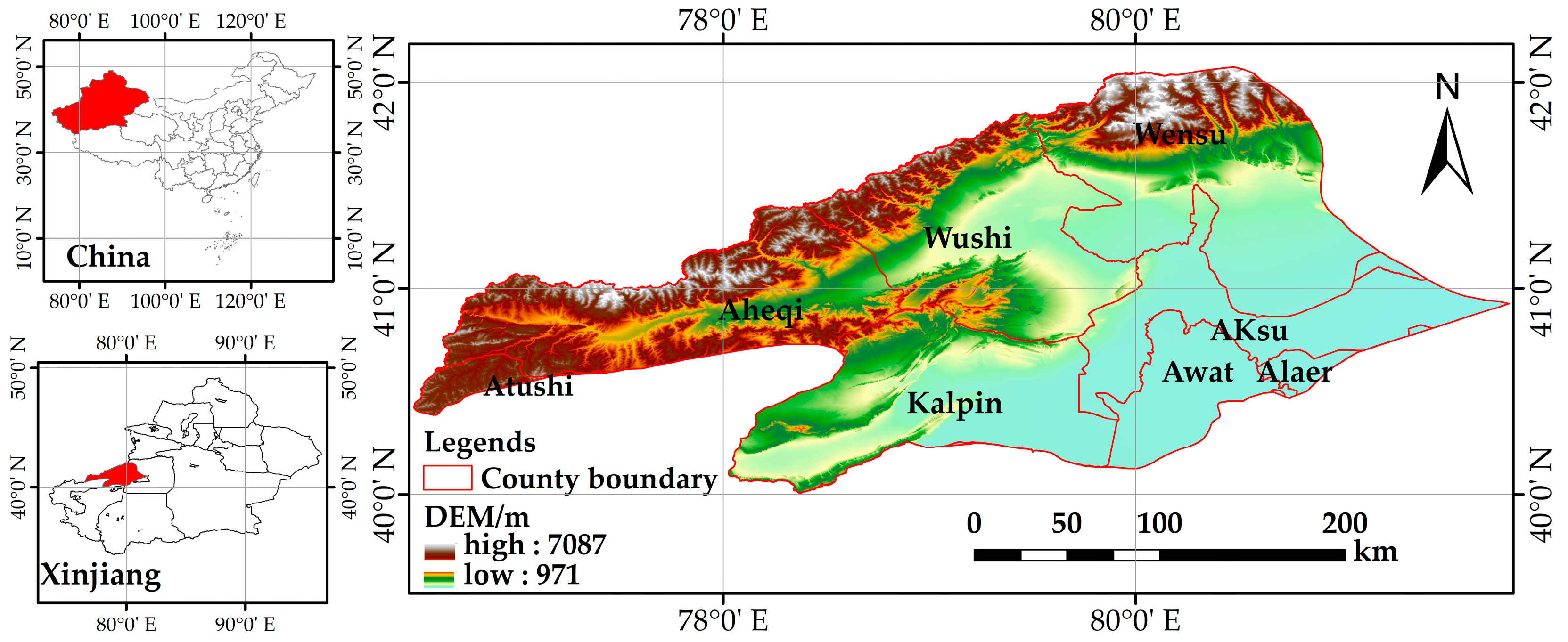
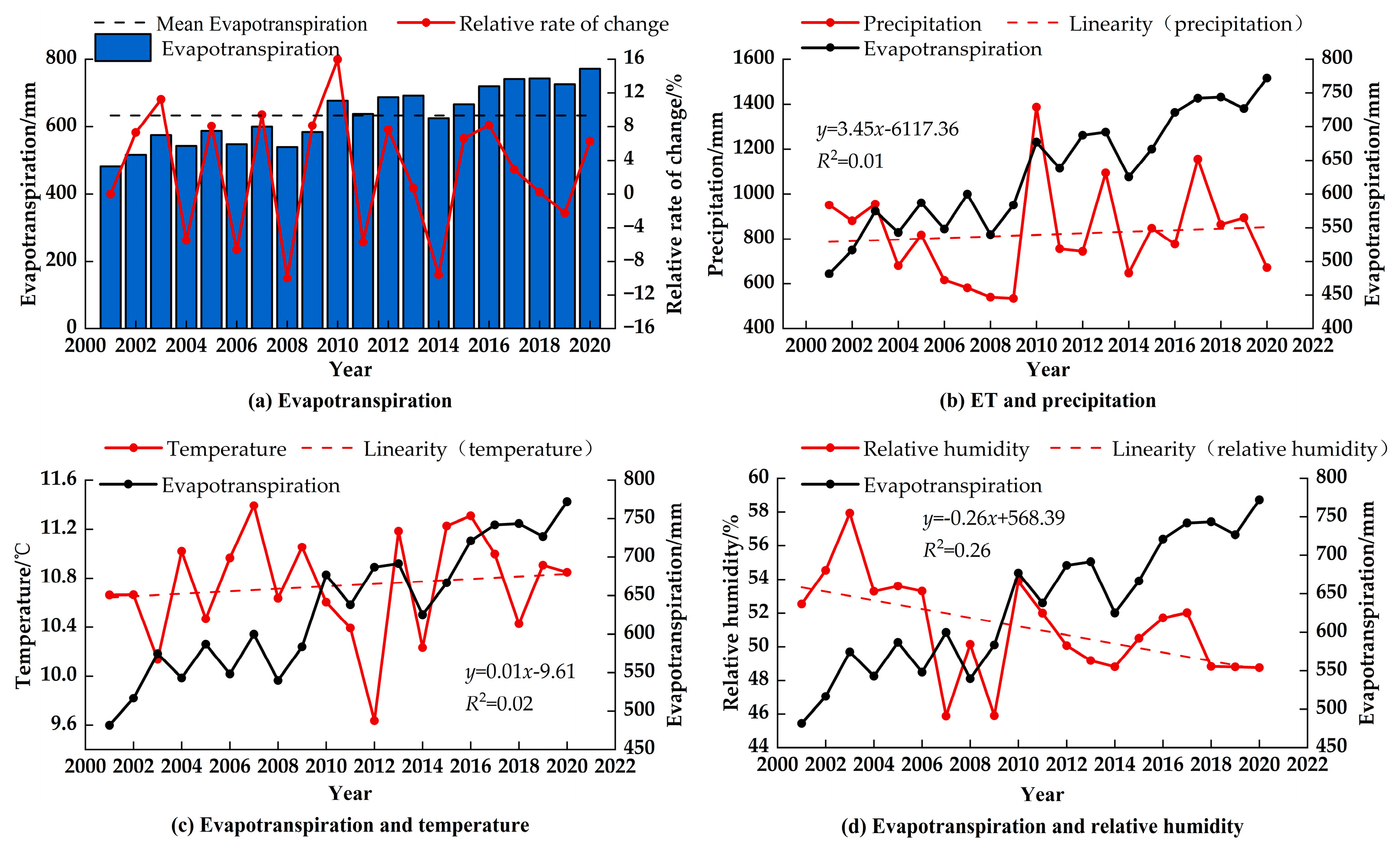


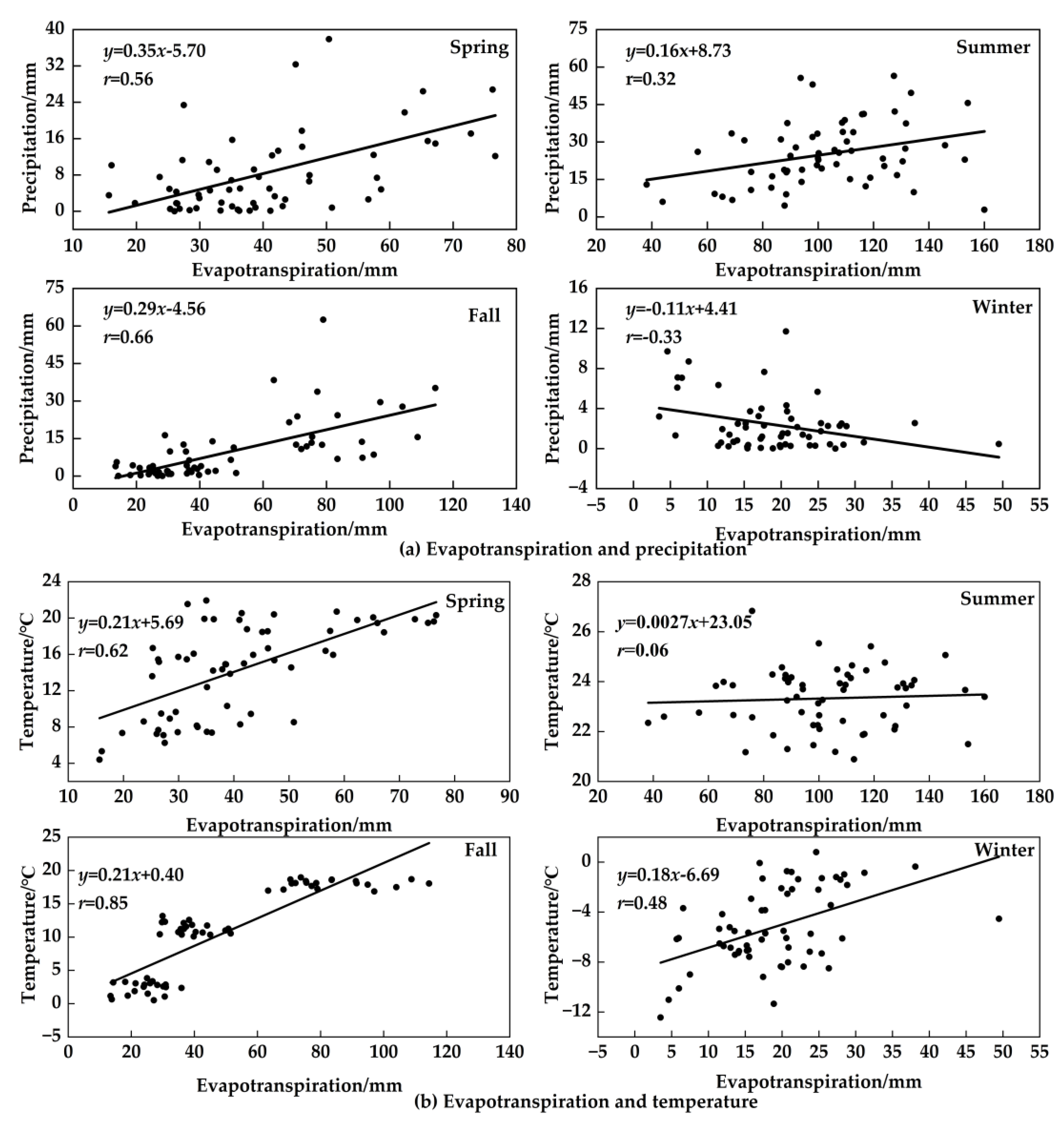
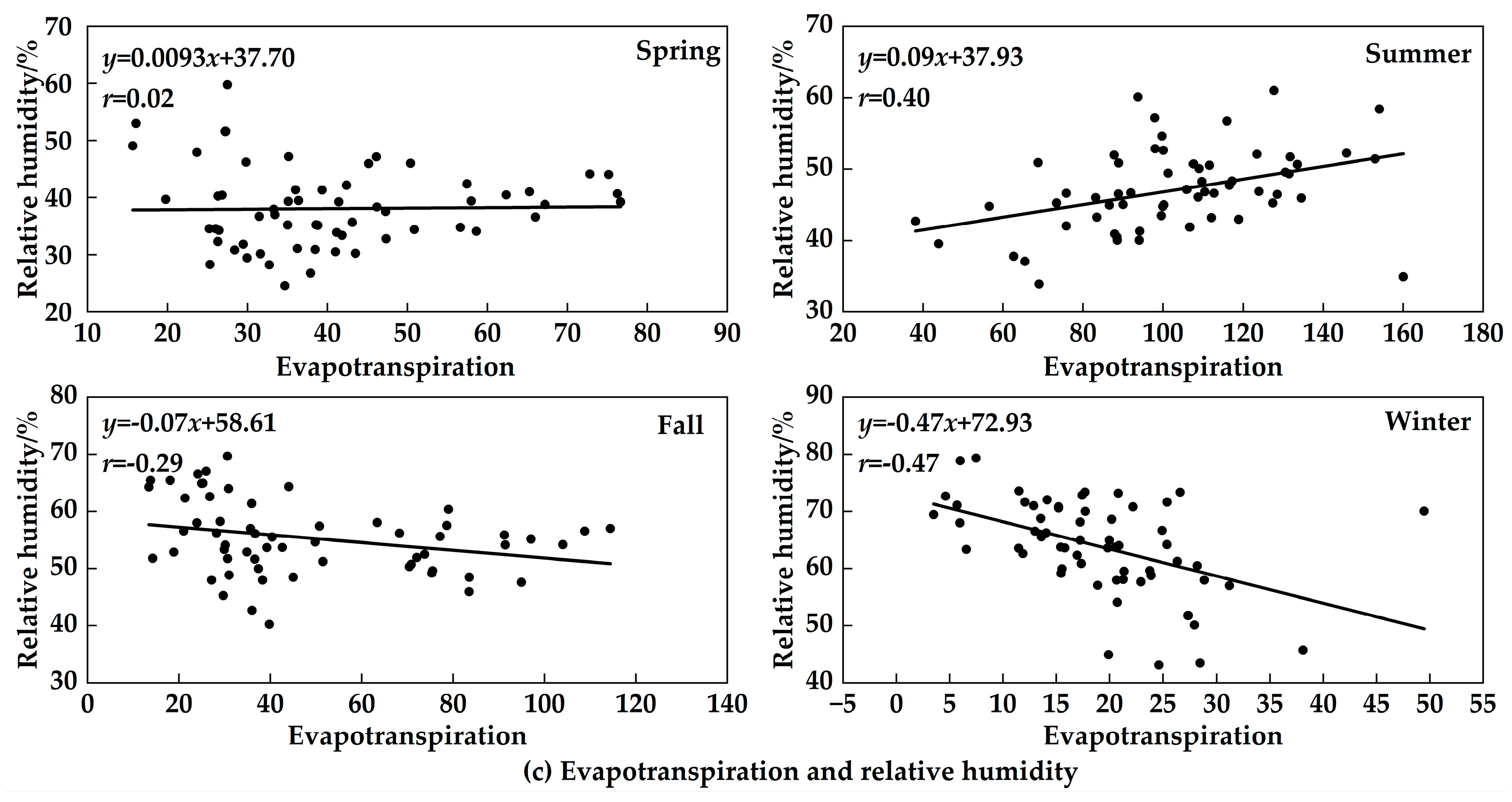

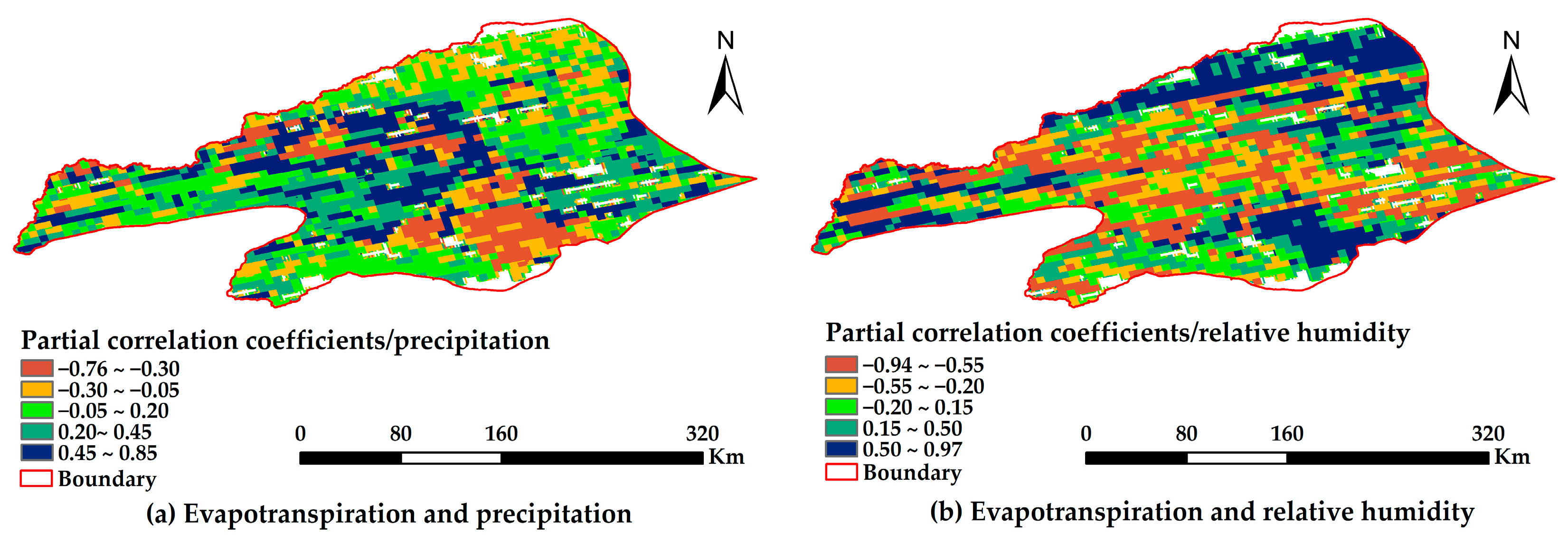

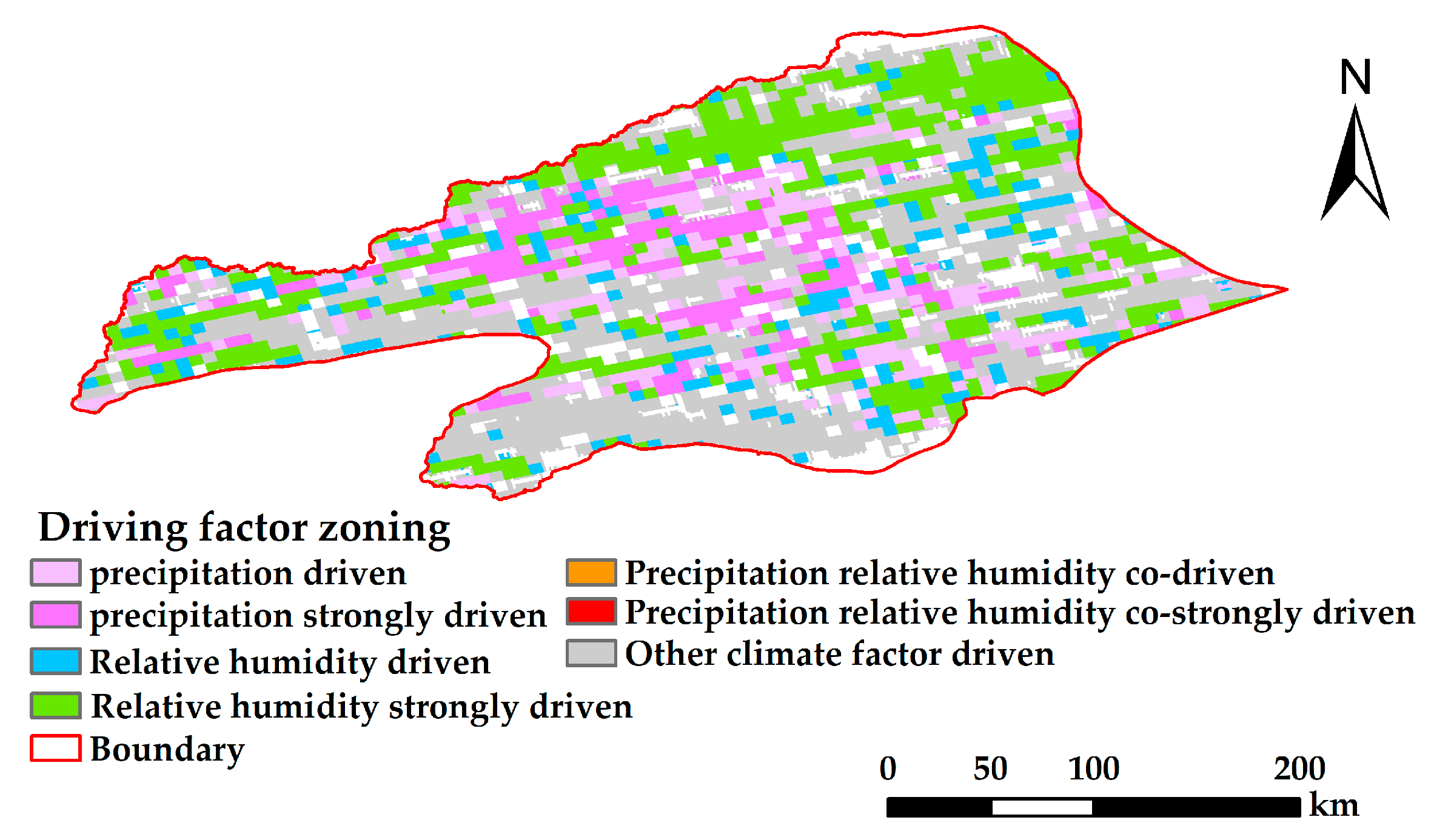

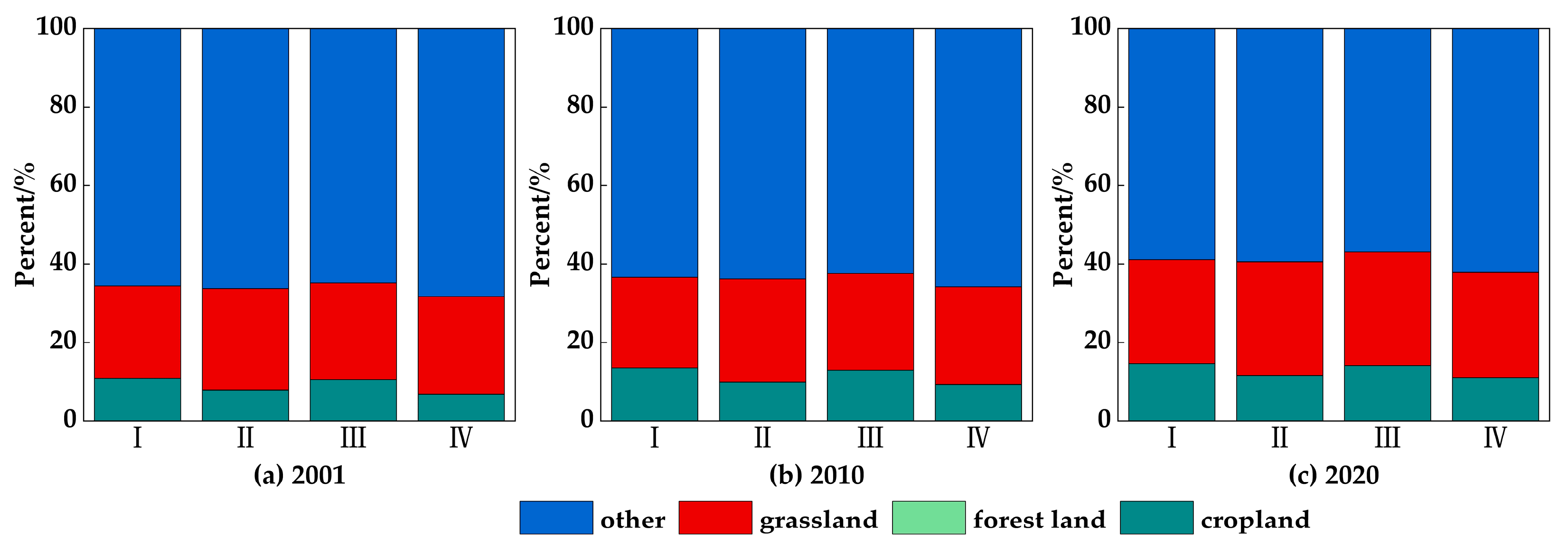
| Types of Drivers of Evapotranspiration | t-Test (Precipitation) | t-Test (Relative Humidity) | F-Test | |||
|---|---|---|---|---|---|---|
| α = 0.05 | α = 0.01 | α = 0.05 | α = 0.01 | α = 0.05 | α = 0.01 | |
| Precipitation | |T| ≥ t0.05 | \ | \ | \ | F ≥ f0.05 | \ |
| Precipitation intensity | \ | |T| ≥ t0.01 | \ | \ | \ | F ≥ f0.01 |
| Relative humidity | \ | \ | |T| ≥ t0.05 | \ | F ≥ f0.05 | \ |
| Relative humidity (strong) | \ | \ | \ | |T| ≥ t0.01 | \ | F ≥ f0.01 |
| Precipitation and relative humidity | |T| ≥ t0.05 | \ | |T| ≥ t0.05 | \ | F ≥ f0.05 | \ |
| Precipitation and relative humidity (strongly codriven) | \ | |T| ≥ t0.01 | \ | |T| ≥ t0.01 | \ | F ≥ f0.01 |
| Other climatic factors | |T| < t0.05 | \ | |T| < t0.05 | \ | F < f0.05 | \ |
| β | β > 0 | β = 0 | β < 0 | ||||||
|---|---|---|---|---|---|---|---|---|---|
| Z | 2.58 < Z | 1.96 < Z ≤ 2.58 | 1.65 < Z ≤ 1.96 | Z ≤ 1.65 | Z | Z ≤ 1.65 | 1.65 < Z ≤ 1.96 | 1.96 < Z ≤ 2.58 | 2.58 < Z |
| Trend categories | 4 | 3 | 2 | 1 | 0 | −1 | −2 | −3 | −4 |
| Trend characterisations | Highly significant increase | Significant increase | Slightly significant increase | No significant increase | No change | No significant decrease | Slightly significant decrease | Significant decrease | Highly significant decrease |
Disclaimer/Publisher’s Note: The statements, opinions and data contained in all publications are solely those of the individual author(s) and contributor(s) and not of MDPI and/or the editor(s). MDPI and/or the editor(s) disclaim responsibility for any injury to people or property resulting from any ideas, methods, instructions or products referred to in the content. |
© 2024 by the authors. Licensee MDPI, Basel, Switzerland. This article is an open access article distributed under the terms and conditions of the Creative Commons Attribution (CC BY) license (https://creativecommons.org/licenses/by/4.0/).
Share and Cite
Zheng, G.; Wei, G.; Han, F.; Cao, Y.; Gao, F. Study on the Response Mechanism of Climate and Land Use Change to Evapotranspiration in Aksu River Basin. Atmosphere 2024, 15, 1055. https://doi.org/10.3390/atmos15091055
Zheng G, Wei G, Han F, Cao Y, Gao F. Study on the Response Mechanism of Climate and Land Use Change to Evapotranspiration in Aksu River Basin. Atmosphere. 2024; 15(9):1055. https://doi.org/10.3390/atmos15091055
Chicago/Turabian StyleZheng, Gang, Guanghui Wei, Fanghong Han, Yan Cao, and Fan Gao. 2024. "Study on the Response Mechanism of Climate and Land Use Change to Evapotranspiration in Aksu River Basin" Atmosphere 15, no. 9: 1055. https://doi.org/10.3390/atmos15091055





